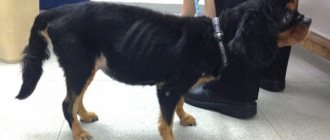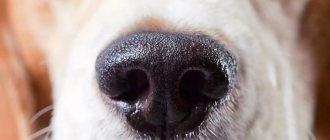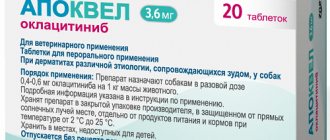The dog behaves restlessly: it constantly itches, whines, and red spots and severe scratches remain on the skin. Typically, such symptoms indicate an incipient immunopathological process or, in simple terms, an allergy.
Of course, there are many reasons for this disorder, but in this article we will talk about the most common one - flea dermatitis in dogs.
Flea dermatitis is a real scourge of our four-legged friends. This infection is especially severe in the summer, when the thermometer reaches 25 degrees and air humidity rises to 75%. These conditions are considered ideal for the reproduction of harmful fleas.
Small, ubiquitous insects strive to suck on the fragrant dog’s blood. During this period, owners must take all necessary measures and take care of the safety of their pet. The consequences of an attack by merciless bloodsuckers will become a real problem and will ruin the life of not only the pet itself, but also its owner.
Brief description of the disease
Flea dermatitis is an insect allergy or intolerance to parasite bites. Digging into the skin, the bloodthirsty parasite injects saliva, which prevents blood clotting and, when it gets into it, causes severe intoxication. This colorless liquid contains about fifteen different substances that cause unbearable itching.
In general terms, dermatitis is severe skin irritation caused by allergens. According to statistics, the majority of such reactions in dogs (about 80%) are caused by these small blood-sucking reptiles.
This disease usually affects animals between two and six years of age. Puppies under six months of age are not susceptible to this scourge, since their immunity is too weak and will not give a strong response to the allergen.
Which breeds are more susceptible
Flea dermatitis can occur in any dog, without exception, regardless of gender, age, or breed. The severity of the disease depends on the individual characteristics of the body, the rate of progression and the severity of the allergic reaction.
Dermatitis caused by flea bites is most often diagnosed in representatives of short-haired breeds - dachshunds, Labradors, bulldogs, boxers, Rottweilers, German shepherds.
Mechanism of infection
Did you know that, according to numerous testimonies from veterinarians, in 90% of cases, the majority of skin lesions in their patients are caused by representatives of the blood-sucking order? For some reason, many owners zealously deny the presence of fleas on their four-legged pets, which causes bewilderment among experienced specialists. Owners of small dogs, who “relieve themselves” in a litter box at home, like cats, especially suffer from this misconception. In their opinion, if a pet practically never appears on the street, then this unpleasant problem has nowhere to come from. It's time to dispel dangerous misconceptions.
The flea is a hematophagous insect and, as you probably know, they feed not only on the blood of animals, but also on people. Sensitive tiny insects are able to penetrate apartments and houses:
- from the street;
- from the entrance;
- through windows and cracks.
For the most part, you don't have to be the owner of a furry friend to attract a flea's attention. Without even meaning to, you yourself bring a parasite into your home, for example, on your clothes or dirty shoes.
As a rule, blood-sucking insects hide:
- in sofas;
- mattresses;
- in dust;
- under the parquet;
- in tile cracks;
- behind the baseboards;
- behind the wallpaper and in other secluded corners.
Almost the entire population of tiny bloodsuckers consists of larvae. For a whole year they exist unnoticed in human homes, waiting for their finest hour. And although the main period of outrage of insatiable creatures is considered to be spring, summer and autumn, it is the long stay in the pronymph (pupa) stage that makes these insects very viable and increases the likelihood of flea infestation even in winter.
As you have already understood: fleas are extremely tenacious and dexterous creatures. If a doctor suspects a tailed couch potato is infected with parasites, do not be reckless and deny the diagnosis.
Symptoms of the disease
In total there are about two thousand species and subspecies of fleas. Most of them are parasitic throughout the body, however, a few varieties live exclusively on the face, on and around the ears. Usually, it is almost impossible to notice these tiny creatures with the naked eye, unless the condition of the infected animal has become critical.
As noted earlier, many skin diseases are caused by flea attacks. According to French researchers in 1992, the breeds most susceptible to the saliva of these bloodsuckers are:
- setter;
- fox terrier;
- chow-chow;
- Pekingese;
- spaniel.
There are other equally allergic dogs, such as pit bulls and sharpeis.
The clinical manifestations of parasite infection will depend not only on the sensitivity of the animal, but also on the number of insects on its body. The main signs of infection are:
- restlessness, irritability, barking, whining;
- dry skin, the appearance of peeling and crusts;
- itching, accompanied by endless scratching and licking of the affected areas;
- alopecia, bald patches, excessive hair loss;
- scratches, papules, weeping eczema;
- formation of fibrous nodes in the back, lower back, inner thighs and abdomen;
- hyperpigmentation and thickening of the skin;
- the pet noticeably loses weight and looks bad;
- in some cases, a worried dog refuses to eat and appears lethargic and lethargic.
It is important that even single bites provoke a strong allergic reaction, for example, while walking on the street. Only in 30% of cases do animals experience a slow increase in symptoms.
Main symptoms
As previously noted, maximum irritation with associated allergic signs occurs in dogs with sensitive tissues. An owner can suspect flea dermatitis in their pet based on the following signs:
- due to severe itching, the dog constantly itches, tearing the skin with its claws, bites itself, trying to get rid of insects;
- the skin becomes hot;
- as a result of scratching, abrasions, scratches, and scratches appear on the body;
- by injuring itself, the dog can introduce infection into the wounds, so the appearance of ulcers and abscesses is possible;
- hair falls out, bald patches appear;
- the behavior of the pet changes, it becomes lethargic, apathetic, irritable, whines and barks for no reason;
- digestive problems appear, appetite worsens;
- vomiting is possible.
Also, flea dermatitis can be accompanied by dry skin, seborrheic scales, and crusts on the skin.
Diagnosis of the disease
At the first change in your pet's behavior, immediately seek help from a veterinary clinic. Experienced specialists will quickly detect the problem and make a diagnosis.
The most common methods for identifying fleas are:
- Superficial inspection. Usually this method is not enough, since only in very advanced cases is it easy to detect the presence of insects on the animal’s body. In most cases, fleas are visible only on bare areas, for example, on the stomach, under the arms, and in the groin.
- Leaf and comb method. The doctor takes an ordinary white A4 sheet, sprinkles it generously with water and combs the dog’s lower back with a comb, as if raking fur and skin particles down onto the paper. Flea bodies are immediately visible on a snow-white surface without additional equipment.
- Microscopy of wool. If previous methods have not yielded results or the doctor continues to doubt the cause of the skin reaction, he will take a clump of hair for detailed examination under a microscope. This method is used to look for feces of parasites in the animal's fur.
- Cytology. A scraping is taken from the affected area and carefully examined in the laboratory using magnifying instruments. It is usually used as an additional technique to exclude other possible diseases.
- Blood analysis. Sometimes the doctor takes a blood sample, however, according to many veterinarians, this method is useless. Elevated levels of eosinophils in the blood indicate not only flea infestation, but also helminth damage.
Some clinics may ask you to show your ankles for signs of insect bites. Of course, the method is quite dubious and if the doctor does not offer another way to identify the problem, then you should turn to other specialists.
How to diagnose
At home, it is quite easy to detect potential pathogens of flea dermatitis. Place your pet on a white cloth and lightly dampen the fur by brushing with a wet brush. If black and tan spots are visible on the fabric and surface of the body, the dog is infected with fleas.
In a clinical setting, a doctor diagnoses a disease based on:
- preliminary collection of information anamnesis - the conditions in which the animal is kept, what it eats, where the dog walks, the presence of other pets in the house;
- differential tests - a procedure necessary to clarify the etiology of dermatitis and distinguish the typology of the disease from the symptoms of other skin diseases;
- collection and analysis of clinical tests - for example, with flea dermatitis, the level of leukocytes and red blood cells in the blood decreases.
Consequences of infection
For some reason, some owners are in no hurry to show their constantly scratching dog to a doctor. Unfortunately, in addition to the above-mentioned flea dermatitis with all the ensuing skin irritations and restless behavior of the pet, small bloodsuckers will cause much more serious damage to the health of a mustachioed pet:
- Chronic form. This type of allergy is characterized by constant relapses, provoked by the owner’s connivance towards the problem and unwillingness to treat the pet well. In the end, insect bites will no longer be necessary for painful manifestations.
- Anemia. Some insensitive dogs do not react in any way to the presence of fleas, which, by the way, multiply at lightning speed. For your information, about 70 females per day are capable of sucking about 1 ml of blood, imagine what will happen if they multiply greatly. Often, after being infected by dangerous flukes, dogs, especially representatives of small breeds, suffer from posthemorrhagic anemia.
- Cucumber tapeworm. Another name for this dangerous disease is dipylidia. Hematophages are spreaders of this serious disease, which also affects humans. The dog endlessly licks the itchy spot and accidentally swallows annoying parasites. The causative agent of the disease penetrates the intestines of the animal along with the insect that previously swallowed the larva of a dangerous worm. An adult reaches a length of one meter. Cestodes developing in the intestines absorb nutrients and irritate the internal walls. Their vital activity leads to intestinal bleeding, obstruction and volvulus, which, in turn, will most likely lead to the death of the animal.
Purpose of therapy
After making a diagnosis, the doctor will prescribe the necessary treatment for your pet. Follow the recommendations strictly. Destroying fleas and eliminating the consequences of their outrage on a dog’s body is a rather difficult task, and it is almost impossible to rid the animal of hypersensitivity to saliva.
Of course, the appointment will be made by the attending physician, but the owner would also benefit from information about the most effective treatment methods:
- Lethal dose. Today on the market there is a huge number of all kinds of tablets, sprays, powders, drops, collars that destroy bloodsuckers parasitizing on the dog’s body. You can easily get confused among this diversity. An experienced specialist will select the right products based on the animal’s condition and the severity of symptoms. Preparations based on imidacloprid and fipronil are considered the most effective. The active substances enter the flea through the blood of an infected animal, although they are not absolutely harmless to our tailed pets. In any case, adhere to the veterinarian's instructions and strictly follow the instructions.
- Fighting allergies. Depending on the scale of the lesion and the severity of the form, the patient will be prescribed concomitant medications. Injections of gluconate or calcium chloride, sodium thiosulfate, which is also administered intravenously and, in extreme cases, hormonal preoral drugs such as prednisolone. The listed substances are aimed at reducing the development or completely stopping the allergic reaction.
- External means. The veterinarian will also prescribe special ointments and shampoos that will soothe the unbearable itching and make the four-legged patient feel better.
- Deworming. As previously mentioned, fleas are carriers of worms and other helminths, so this item will definitely be included in the prescription.
Please note that antihistamines such as Tavegil, Suprastin and others, as a rule, are ineffective for dogs and competent doctors do not prescribe them.
Folk remedies against fleas
You can poison fleas not only with chemicals, but also with folk remedies. There are many effective methods.
Herbs
Wormwood has a specific smell.
Insects are afraid of the bitter taste and specific smell of wormwood. Based on it, a decoction is prepared for bathing the animal.
To do this, take 1 tbsp. l. herbs, add 1 liter of water and cook for 15 minutes. Strain and add to the bath. You can scatter the grass around the apartment.
Celandine is often used against fleas, on the basis of which an infusion is prepared. To do this, combine the crushed plant and vodka in equal proportions.
Only 3 drops of the product are poured onto the withers, because celandine is poisonous.
Garlic
Take 2 small cloves of garlic, chop them, pour 200 ml of boiling water and leave for 7 hours. The resulting liquid is used to wipe the dog’s head and neck, as well as those places that the dog cannot reach. It is allowed to add a little garlic to your pet's food, but only after the approval of a veterinarian.
Onion
Folk remedies for killing fleas on dogs can be quite effective.
Onions are good for getting rid of fleas. To prepare the product, take one small onion, a bar of ordinary soap and water.
Rub the soap, add water and add chopped onions. Stir and wash the animal with the resulting mixture.
Laundry soap
Rub a bar of laundry soap, place it in a glass of warm water and leave for 2.5 hours. Add 2 crushed cloves of garlic, mix, apply for 8-10 minutes to the dog’s hair and rinse.
You can treat an animal several times, especially if there are a lot of insects. A medicated shampoo is also prepared. To do this, soap is added not to water, but to a decoction of eucalyptus.
Essential oils
Parasites are afraid of the scents of eucalyptus, citrus, tea tree and lavender. To prepare a medicinal spray, take 5 drops of one oil, combine with 150 ml of water and spray the animal before a walk. In addition, you can add essential oils to shampoos, and also apply a few drops to your dog’s bed. Protection against parasites lasts as long as the scent is present.
Needles
You can place pine needles near the animal's bed or under the bedding. This helps scare away insects.
Vinegar
Fleas cannot tolerate sour odors, so you can fight them with apple cider vinegar. Dogs' skin is sensitive to acid, so it needs to be diluted properly. It is necessary to rub 40 g of laundry soap and place the shavings in 1 liter of water. Add 200 ml of apple cider vinegar to the solution and mix.
The product should be applied to the animal’s fur immediately after preparation, until the smell dissipates.
Top 4 best drops
Drops containing insecticides help achieve the best results in the fight against annoying bloodsuckers. Check out the highest quality, most effective and modern products:
- Bars AVZ. A universal remedy, suitable for both adult dogs and puppies. The protective effect lasts for a month. Does not cause side effects.
- Advantix for large breeds from Bayer. It does not penetrate into the pet’s blood, but remains in the sebaceous glands. Designed for large mature dogs weighing over 25 kg, as well as for growing young animals from seven weeks of age.
- Advantix for medium breeds from Bayer. Does not leave excess oil on the coat, protects against any midges and is considered a hypoallergenic product. It is better to use it together with a flea collar from the same manufacturer.
- Frontline Combo S Merial. It is also not absorbed into the blood and destroys eggs and larvae. Using a special bottle, it is convenient to apply the solution directly while walking.
It is important that after using antiparasitic agents, it is better to put a special collar on the animal, which will prevent the dog from licking the strong-smelling liquid.
Preventive measures
Given the extent of the flea population, it is quite difficult to completely get rid of the insects.
Measures to prevent infection of domestic animals with ectoparasites:
- Regular sanitary treatment of the room where the pet is, as well as the things it touches.
- Systematic treatment of the dog with antiparasitic agents containing fipronil, selamentin or imidacloprid.
- Using anti-flea collars or shampoos.
- Make sure that your pet does not come into contact with stray animals during walks.
- Regular and thorough examination of areas of the body with high humidity - the parotid, perianal area, inner thighs and withers.
Treatment of the territory
Some owners, after treating their dog, forget to disinfest the dog. Here are a few simple rules to follow:
- Thoroughly vacuum all areas where the animal is. Don't forget about your car, bed, and carrier. After cleaning, throw away the bag or filter.
- Treat surfaces with insecticidal preparations. Neostomozan or Butox will do. As a rule, one ampoule is diluted in two liters of water; in any case, it is better to follow the instructions on the package.
What happens if dermatitis is left unattended?
The condition poses a serious danger to the animal and negatively affects its general condition. If the pathology is severe, vomiting and nausea due to intoxication of the body are possible.
In addition, bacterial infection gets into the wounds. The result is purulent inflammatory processes.
When a pet's immunity is weakened, the risk of sepsis increases when purulent wounds form. If treatment is not started in a timely manner, death cannot be ruled out.
Prevention
Of course, even after all the measures taken, no one will give you a guarantee that the dog will not become infected with the ubiquitous parasites again. However, a caring and attentive owner will prevent re-infection of the pet. If you want to avoid this scourge, use the following tips from experts:
- Regularly inspect your dog’s fur and body for parasites;
- limit your dog’s contact with stray animals;
- periodically treat your pet’s bed and carpet with insecticides;
- during the “flea season”, be sure to treat the animal with antiparasitic agents;
- monitor the animal’s nutrition and provide your pet with a balanced diet rich in vitamins and microelements;
- Follow the rules of hygiene and carefully care for your tailed friend.
The most modern method of preventing fleas is injections. The injection is given directly by a doctor in the clinic. Usually the injection lasts for six months and during this time the animal is guaranteed not to pick up arrogant parasites.











